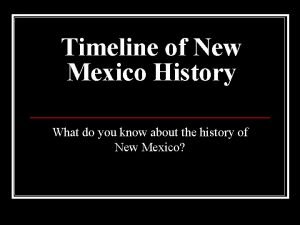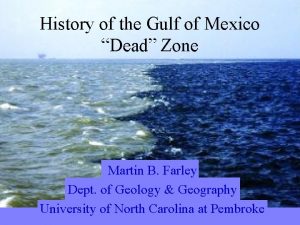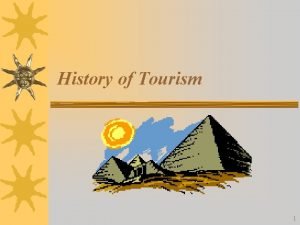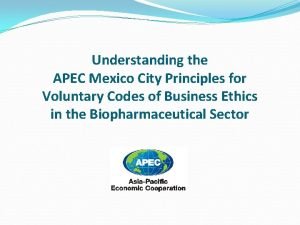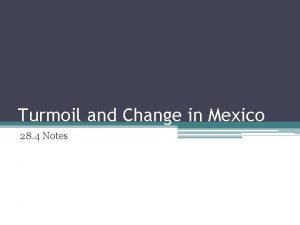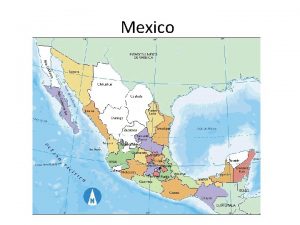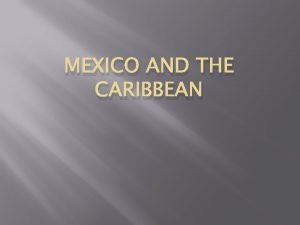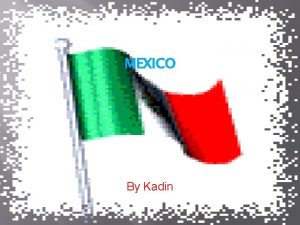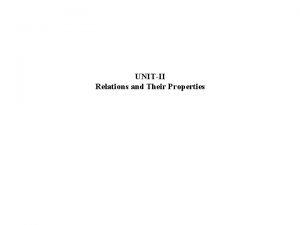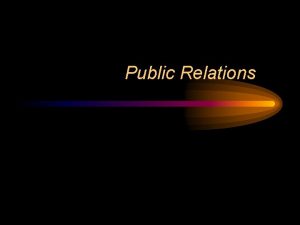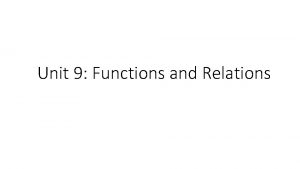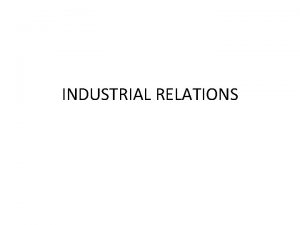US Mexico Relations History Early history U S













- Slides: 13

US- Mexico Relations

History Early history U. S. -Mexico relations grew out of the earlier relations between the fledgling nation of the United States and the Spanish Empire. Modern Mexico formed the core area of the Viceroyalty of New Spain at the time the United States gained independence from Great Britain in the American Revolutionary War (1775– 1783). Spain had served as an ally to the American colonists in that war. The aspect of Spanish-American relations that would bear most prominently on later relations between the U. S. and Mexico was the ownership of Texas. In the early 19 th century the United States claimed that Texas was part of the territory of Louisiana, and therefore had been rightfully acquired by the United States as part of the Louisiana Purchase from France in 1803. The Spanish, however, claimed it was not, as the western boundaries of Louisiana were not clearly defined. In 1819 the dispute was resolved with the signing of the Adams– Onís Treaty, in which the United States relinquished its claims to Texas and instead purchased Spanish Florida. In 1821 Mexico finally gained independence from Spain, and was soon recognized by the United States. The two countries quickly established diplomatic relations. Both Mexico and the United States respected the boundaries established by the Adams–Onís Treaty, but certain elements in the United States were greatly displeased with the treaty, as it relinquished rights to Texas remained a focal point of U. S-Mexico relations for decades. The relationship was further affected by internal struggles within the two countries: in Mexico these included concerns over the establishment of a centralized government, while in the United States it centered around the debate over the expansion of slavery. Beginning in the 1820 s Americans and other non. Mexicans began to settle in eastern Texas in large numbers. These settlers, known as Texians, were frequently at odds with the Mexican government. Their disagreements led to the Texas Revolution, one of a series of independence movements that came to the fore following the 1835 amendments to the Constitution of Mexico, which substantially altered the governance of the country. Prior to the Texas Revolution the general public of the United States was indifferent to Texas, but afterward, public opinion was increasingly sympathetic to the Texians. Following the war a Republic of Texas was declared, though independence was not recognized by Mexico, and the boundaries between the two were never agreed upon. In 1845 the United States annexed Texas, leading to a major border dispute and eventually to the Mexican. American War.

History Continued…. The Mexican- American War The Mexican-American War was fought from 1846 to 1848. The war started for the dispute of the border between Texas and Mexico. The United States believed the border was the Rio Bravo (known in the U. S. as Rio Grande). Mexico believed the border was the Nueces River. In the 1840 s the United States annexed Texas and in 1845 Texas became a state. Officially, however, Texas still belonged to Mexico and when U. S. troops under General Zachary Taylor crossed into Texas, Mexico sent troops, considering the move as an act of war by the U. S. This eventually resulted in President Polk declaring war on Mexico. The war proved disastrous for Mexico. In September 1847 U. S. troops under General Winfield Scott invaded Mexico City. The war ended in a decisive U. S. victory, and as a result Mexico was forced to sell all of its northernmost territory, including California and New Mexico to the United States in the Mexican Cession. Additionally, Mexico relinquished its claims to Texas, and the United States forgave Mexico's debts to U. S. citizens. In 1853 the United States purchased additional land from Mexico in the Gadsden Purchase. http: //www. latenightwithjimmyfallon. com/blogs/ 2010/01/remeber-this-the-gadsden-purchase/

The Modern Era The “War on Drugs” The War on Drugs is a campaign of prohibition and foreign military aid and military intervention being undertaken by the United States government, with the assistance of participating countries, intended to both define and reduce the illegal drug trade. This initiative includes a set of drug policies of the United States that are intended to discourage the production, distribution, and consumption of illegal psychoactive drugs. The term "War on Drugs" was first used by President Richard Nixon in 1971 Although Nixon coined the term "War on Drugs" when he first used it in 1971, the policies that his administration implemented as part of the Comprehensive Drug Abuse Prevention and Control Act of 1970 were a continuation of drug prohibition policies in the U. S. , which started in 1914. As early as 1982, Vice President George H. W. Bush and his aides began pushing for the involvement of the CIA and U. S. military in drug interdiction efforts. The Office of National Drug Control Policy (ONDCP) was originally established by the National Narcotics Leadership Act of 1988, which mandated a national anti-drug media campaign for youth, which would later become the National Youth Anti-Drug Media Campaign. The director of ONDCP is commonly known as the Drug czar, and it was first implemented in 1989 under President George H. W. Bush, and raised to cabinet-level status by Bill Clinton in 1993. These activities subsequently funded by the Treasury and General Government Appropriations Act of 1998 formally creating the National Youth Anti-Drug Media Campaign. The Drug-Free Media Campaign Act of 1998 codified the campaign. Today "The War On Drugs Has Failed", said a self-appointed 19 member commission on June 2, 2011, including former Uited Nations Secretary General Kofi Annan, Mexico's former President Ernesto Zedillo, Brazil's ex-President Fernando Henrique Cardoso and former Colombian President Cesar Gaviria, as well as the former U. S. Federal Reserve chairman Paul Volcker and the current Prime Minister of Greece, George Papandreou. The panel also featured prominent Latin American writers Carlos Fuentes and Mario Vargas Llosa, the EU's former foreign policy chief Javier Solana, and George Schultz, a former U. S. Secretary of State. Rafael Lemaitre, ONDCP Communications Director, issued a response the same day stating that President Obama's policy on drugs is a marked departure from previous approaches to drug policy. U. S. Surgeon General Regina Benjamin also released the first ever National Prevention Strategy. Two weeks later, former President Jimmy Carter wrote an op-ed in The New York Times explicitly endorsing the commission's initiative. The U. S. federal government spent over $15 billion in 2010 on the War on Drugs, a rate of about $500 per second

War on Drugs

War on Drugs Current Plans Merida Initiative ▪ The Mérida Initiative is a security cooperation approved on June 30, 2008, between the United States and the government of Mexico and the countries of Central America, with the aim of combating the threats of drug trafficking and transnational crime. The Mérida Initiative appropriated $1. 4 billion in a three year commitment (2008– 2010) to the Mexican government for military and law enforcement training and equipment, as well as technical advice and training to strengthen the national justice systems. No weapons are included in the plan Los Zetas Outrage A 2008 study by Harvard economist Jeffrey A. Miron has estimated that legalizing drugs would inject $76. 8 billion a year into the U. S. economy — $44. 1 billion from law enforcement savings, and at least $32. 7 billion in tax revenue ($6. 7 billion from marijuana, $22. 5 billion from cocaine and heroin, remainder from other drugs). Low taxation in Central American countries has been credited with weakening the region's response in dealing with drug traffickers. Many cartels, especially Los Zetas have taken advantage of the limited resources of these nations. the second most powerful drug cartel in Mexico and considered by the U. S. Drug Enforcement Administration as the most violent drug cartel and paramilitary enforcement group in Mexico. Los Zetas is a criminal organization dedicated mostly to international illegal drug trade, assassinations, extortion, kidnapping and other organized crime activities. This drug cartel, now led by Heriberto Lazcano, was founded by a group of over 30 former Mexican Army Special Forces deserters and includes corrupt former federal, state, and local police officers, as well as ex-Kaibiles from Guatemala. Los Zetas started as the military wing and private mercenary army of the Gulf Cartel, but after the arrest of the Gulf Cartel's leader, Osiel Cárdenas Guillen, the two entities became a combined trafficking force, with the Zetas taking a more active leadership role in drug trafficking. In 2010, however, Los Zetas began to operate independently from the Gulf Cartel structure. The rupture of Los Zetas and the Gulf Cartel has led to a bloody turf war, predominantly in the states of Nuevo Leon and Tamaulipas. They have also carried out multiple massacres and terrorist attacks on civilians, such as the 2011 Monterrey casino attack, where 52 people were killed, the 2010 Tamaulipas massacre, where 72 migrants were found dead, the 2011 Tamaulipas massacre, where 193 people were killed, the massacre of 27 farmers in Guatemala, and the 2008 Morelia grenade attacks, where 8 were killed and over 100 were injured. In addition, sources reveal that Los Zetas may also be responsible for the death of 249 people at the 2011 Durango massacres and for the 2010 Puebla oil pipeline explosion, which killed 28 people, injured 52, and damaged over 115 homes

Los Zetas

The Border The United States–Mexico border is the international border between the United States and Mexico. It runs from Imperial Beach, California, and Tijuana, Baja California, in the west to Matamoros, Tamaulipas, and Brownsville, Texas, in the east, and traverses a variety of terrains, ranging from major urban areas to inhospitable deserts. From the Gulf of Mexico it follows the course of the Rio Grande (Río Bravo del Norte) to the border crossing at El Paso, Texas, and Ciudad Juárez, Chihuahua; westward from that binational conurbation it crosses vast tracts of the Sonoran and Chihuahuan Desert, the Colorado River Delta, westward to the binational conurbation of San Diego and Tijuana before reaching the Pacific Ocean. The USMexican border is considered an open border. The U. S. –Mexico border has the second highest number of both legal and illegal crossings of any land border in the world, behind the Canada – United States border. The border is guarded by more than twenty thousand border patrol agents, more than any time in its history. However they only have "effective control" of less than 700 miles (1, 100 km) of the 1, 954 miles (3, 145 km) of total border, with an ability to actually prevent or stop illegal entries along 129 miles (208 km) of that border. The border is paralleled by United States Border Patrol Interior Checkpoints at major roads generally between 25 and 75 miles (121 km) to the U. S. side of the border, and garitas generally within 50 km of the border on the Mexican side. There an estimated half a million illegal entries into the United States each year. Border Patrol activity is concentrated around big border cities such as San Diego and El Paso which do have extensive border fencing. This means that the flow of illegal immigrants is diverted into rural mountainous and desert areas, leading to several hundred migrant deaths along the Mexico-U. S. border of those attempting to cross into the United States from Mexico without authorization from the Federal government of the United States. Each state in the United States has a National Guard organization that could, in principle, be placed on the border at a state governor's discretion to assist with border security; many states also have a backup to the National Guard called the State Defense Force that could, in an emergency, also be activated for this purpose. However, few governors have done this. Many governors fear a backlash from local businesses and ever increasing communities of Latinos. Arizona and New Mexico have currently declared the counties that border Mexico to be under serious duress caused by uncontrolled illegal migration, thereby enabling governors to deploy National Guardsmen to the international border. However, Senator John Mc. Cain (R-Arizona) has opposed some measures intended to reduce illegal immigration through enforcement and proposed a bill calling for earned legalization (which many call amnesty) in the Senate. Texas governor Rick Perry has called for the deployment of national guardsmen to watch certain high-traffic spots of the Texas/Mexico border, partly as a response to an incident in 2006 where U. S. officers involved in a pursuit in western Texas lost suspected drug smugglers when their 4 x 4 vehicle crossed the Rio Grande and was met by several men armed with assault rifles and dressed in Mexican military uniforms. In May 2006, President Bush announced a plan whereby up to 6, 000 National Guardsmen would help build facilities on the border to assist the Border Patrol with tactical and technical measures but not enforcement duties. There has been some resistance: in California, Governor Arnold Schwarzenegger initially denied Bush's request to deploy 3, 000 National Guard troops to the California-Baja California border. [Later Schwarzenegger changed his mind after being reassured of reimbursement and replacement if they are needed elsewhere and deployed over 1600 California National Guard troops to the border.

The Border Attempts to complete the construction of the United States– Mexico barrier have been challenged by the Mexican government, illegal immigrants living in the United States, and various U. S. based Chicano organizations. According to proponents of open border policies, agricultural work is one of the many types of work that illegal immigrants fill that could not be easily filled by United States citizens. Opponents counter that U. S. citizens would gladly take these jobs if offered decent wages. In December 2005, the United States House of Representatives voted to build a separation barrier along parts of the border. A companion vote in the United States Senate on May 17, 2006 included a plan to blockade 860 miles (1, 380 km) of the border with vehicle barriers and triple-layer fencing. Although those bills died in committee, eventually the Secure Fence Act of 2006 was passed providing for the construction of 700 miles (1, 100 km) of high-security fencing. Proponents hope that barriers of various types running the length of the border will reduce illegal drug smuggling and illegal immigration drastically. According to Dr. Douglas Massey of Princeton University and other experts the efforts to curtail illegal immigration by means of security has done nothing but redirect the migration flows into the most desolate and desert areas of the border, thus increasing the mortality rate of illegal immigrants. Instead, they remain in the U. S. for longer periods of time and eventually bring their families with them. President Bush has presented an initiative to reinstate a Guest worker program or expand the H-2 B program to fill the perceived needs of labor for some areas of the U. S. and, at the same time, has pushed to strengthen the security measures at the border to stop suspected illegal immigrants, terrorists, and narcotics dealers from entering the U. S.

The Border Enforcement 71% of respondents in a 2006 Quinnipiac University Poll believed that enforcement of immigration laws will require additional measures beyond a border fence, with 65% of respondents supporting employer fines. 77% of respondents to a Los Angeles Times/Bloomberg Poll support employer fines. A later NBC/Wall Street Journal poll indicates 57% strongly favor employer fines and 17% somewhat favor them, while 44% strongly favor increased border security and 19% strongly oppose. The Manhattan Institute reported that 78% of likely Republican voters favor a proposal combining increased border security, tougher penalties for employers who hire illegal workers, and allowing illegal aliens to register for a temporary worker program that includes a path to citizenship. ▪ Respondents favored the program over a deportation and enforcement-only plan 58% to 33%. The Quinnipiac poll reports that 65% of adults support a guest worker program for illegal immigrants. Following the passage of Arizona's Support Our Law Enforcement and Safe Neighborhoods Act n April, 2010, which authorizes police officials to question persons on their immigration status if there is reasonable suspicion that they are illegally in the country or committing other violations not related to their immigration status, numerous polls showed widespread support for the law. ▪ A Rasmussen poll found that 60% of the electorate support ▪ ▪ such a law while 31% are opposed to such a law. A New York Times poll showed similar results: 51% of Americans felt the law was "about right" in its dealings with illegal immigration, 9% felt that its measures did not go far enough to address the problem while 36% have negative opinions regarding such a law. Arizona Border Response of government An ABC News Poll, indicates that most respondents (67%) believe the United States is not doing enough to keep illegal immigrants from coming into the country and, according to a CBS News/New York Times poll most Americans believe that US immigration policy needs either fundamental changes (41%) or to be completely rebuilt (49%). In an opinion poll by Zogby International in 2005, voters were also asked, "Do you support or oppose the Bush administration's proposal to give millions of illegal aliens guest worker status and the opportunity to become citizens? " ▪ 35% gave their support; 56 percent disagreed. The same poll noted a huge majority, 81%, believes local and state police should help federal authorities enforce laws against illegal immigration. Federal response In choosing a presidential candidate, most respondents to a Los Angeles Times/Bloomberg Poll consider his or her stand on illegal immigration to be either an important (66%) or the most important (15%) issue, while a clear minority consider it to be either not too important (16%) or not important at all (2%). Most respondents (51%) would be upset if Congress does not pass an immigration bill while significantly fewer (22%) would be pleased. A Chicago Tribune Super Tuesday exit poll shows that "Experts following the immigration debate claim Republicans had hoped illegal immigration would become a wedge issue between the two parties in the 2008 presidential election. " The report adds, "Voters across the country overwhelmingly and consistently have named the economy as their number one issue, in exit poll data from Super Tuesday and subsequent primaries. . . "

Obama’s Immigration Policy The White House Immigration - Guiding Principles ▪ "President Obama believes that our broken immigration system can only be fixed by putting politics aside and offering a complete solution that secures our border, enforces our laws, and reaffirms our heritage as a nation of immigrants. He believes our immigration policy should be driven by our best judgment of what is in the economic interest of the United States and what is in the best interest of the American worker. ▪ "President Obama recognizes that an orderly, controlled border and an immigration system designed to meet our economic needs are important pillars of a healthy and robust economy. Strengthen Border Control ▪ "President Obama will protect the integrity of our borders by investing in additional personnel, infrastructure, and technology on the border and at our ports of entry. Improve Our Immigration System ▪ "President Obama will fix the dysfunctional immigration bureaucracy and enable legal immigration so that families can stay together. Remove Incentives to Enter Illegally ▪ "President Obama will remove incentives to enter the country illegally by preventing employers from hiring undocumented workers and enforcing the law. Bring People Out of the Shadows ▪ "President Obama supports a system that allows undocumented immigrants who are in good standing to pay a fine, learn English, and go to the back of the line for the opportunity to become citizens. Work with Mexico ▪ "President Obama will promote economic development in Mexico to decrease the economic desperation that leads to illegal immigration. "


Today’s Issues Economics The United States and Mexico have close economic ties. The US is Mexico's largest trading partner, accounting for close to half of all exports in 2008 and more than half of all imports in 2009. For the U. S. , Mexico is the third largest trading partner after Canada and China as of June 2010. The two countries and Canada have signed the North American Free Trade Agreement (NAFTA) in 1994 with the goal of eliminating barriers to trade and investment. Foreign direct investment (FDI) into Mexico has risen dramatically since NAFTA went into effect and in 2008, 41% of all FDI came from U. S. sources. Roughly half of this investment goes to manufacturing. One U. S. company, Wal-Mart, is the largest private sector employer in Mexico. Globalization is the increasing interconnectedness of people and places as a result of advances in transport, communication, and information technologies that causes political, economical, and cultural convergence. Latin America has emerged from the economic doldrums of the 1970 s and 1980 s to become a commercial power of its own right in the 1990 s. Seeds were planted in the 1980 s with the movements towards democracy and free market economies. Mexico has become a member of NAFTA, Mercosur, born in 1988, achieved full internal free trade among member-states Brazil, Argentina, Paraguay and Uruguay by its 1994 deadline. Positive ▪ ▪ The border between Mexico and the United States spans four U. S. states, six Mexican states, and has over twenty commercial crossings. In contrast to the accepted wisdom of the 1970 s and 1980 s, international firms in the 1990 s see Latin America as a springboard into America. Companies such as Honda and Mercedes have built new plants or upgraded existing ones in Mexico to reap the advantages of the free trade that the NAFTA agreement promised. The surge of consumption south of the American border has also sparked the interest of both American and international retailers. After an extensive study of Mexican consumers in its 22 stores on the U. S. -Mexico border, J. C. Penney announced plans to open 20 stores in Mexico and Chile, where the Home Depot briefly had 12 stores in the early 2000 s. Wal-Mart followed its initial push into Mexico, Canada and Puerto Rico with aggressive moves into Brazil, Chile and Argentina. Corona is the number one imported beer in America by volume with a 29% share of the beer market. Negative ▪ While it can be argued that the effects of economic liberalization over three decades have been largely positive, concerns are rising in capitals throughout the world that accelerating change is carrying an increasingly high price in terms of unemployment, social dislocation, income disparities, the exploitation of workers and environmental degradation. This can be seen specifically in cases of the maquiladora factories on the U. S. -Mexico border. Cases of exploitative labor, low wages, long hours, and sexual misconduct are evident.
 Employee relations in public relations
Employee relations in public relations Early cpr and early defibrillation can: *
Early cpr and early defibrillation can: * Timeline of new mexico history
Timeline of new mexico history Gulf of mexico history
Gulf of mexico history History of international relations
History of international relations Section 17-2 earth's early history answer key
Section 17-2 earth's early history answer key 17-2 earth's early history
17-2 earth's early history Section 17-2 earth's early history
Section 17-2 earth's early history Egyptian floral
Egyptian floral Early beginnings history of tourism
Early beginnings history of tourism Early american floral design history
Early american floral design history What do historians call the early period of human history
What do historians call the early period of human history Mexico city principle
Mexico city principle Turmoil and change in mexico
Turmoil and change in mexico


